Fadi G. Lakkis, Professor of Surgery at the University of Pittsburgh, charts the successes and challenges of organ transplantation
Organ transplantation is a great success story that started 70 years ago with the first successful kidney transplant between identical twin brothers in Boston, Massachusetts.
Now, more than 180,000 transplants are performed each year between related and unrelated individuals worldwide, thanks to advances in surgical techniques and medicines known as immunosuppressants. Immunosuppressants weaken the recipient’s immune system and prevent it from rejecting the transplanted organ.
In addition to life-saving organs such as kidneys, livers, hearts, and lungs given to patients who otherwise would perish without them, more and more humans are receiving transplants that are not life-sustaining but that enhance life quality.
Two examples are uterus transplants for infertile women and face or forearm transplants for people who have suffered severe burns or trauma. Transplantation has indeed become an accepted and, in some cases, routine medical procedure that gives patients a new lease on life.
Organ transplantation challenges
Unless a patient receives an organ from a genetically identical twin sibling, which is rare, transplanted organs are foreign to the recipient. The immune system promptly rejects them if immunosuppression is not administered for the life of the transplant.
Immunosuppressants are not without side effects. They increase the risks of infection, malignancy, cardiovascular disease, and other untoward side effects such as diabetes, high blood pressure, and impaired wound healing. They can also be toxic to the kidneys.
Even if well-tolerated, immunosuppressants are not a cure for rejection. About half of all transplanted organs, on average, are rejected ten to 12 years after transplantation, and the majority by 20 years.
Therefore, many patients will require second or third transplants, which are not readily available. There are many challenges that must be surmounted to advance the field of transplantation. They include:
Better immunosuppressants that are more effective and have fewer side effects.
The possibility of attaining transplantation tolerance is the situation whereby the immune system ceases to recognize the transplanted organ as foreign and does not reject it.
In practical terms, tolerant patients can have a functional organ transplant for life after an initial medical manipulation but without the need for long-term immunosuppression.
Increasing the supply of organs available for transplantation, either by improved organ procurement and allocation systems or the long-sought-after dream of xenotransplantation (using animal organs, such as pig organs, for transplantation into humans).
Solutions, from marine invertebrates to humans
The solution is nothing short of more profound research into the mechanisms of transplant rejection and immune tolerance and the application of fundamental discoveries to patients. Future success will require a more expansive imagination, seeking answers in nature as well as experimental models developed within the confines of the laboratory.
Nature does have an important lesson to teach us about organ rejection. Many simple and complex organisms, invertebrate and vertebrate, have the uncanny ability to distinguish foreign tissues from self-tissues and reject them.
An excellent example is marine invertebrates, such as species belonging to Hydractinia, that fuse with kin but reject unrelated individuals (Figure). These animals lack the more resourceful, adaptive immune systems that we humans have but nevertheless possess a more basic, innate immune system that relies on fewer cell types.
Armed with insights from Hydractinia, discoveries have been made that show that the innate component of our immune system is also capable of sensing foreign organs through specific receptors that amplify and perpetuate rejection. These discoveries, made in mice, also apply to humans. They promise to help solve the problem of slow attrition of transplanted organs, known as chronic rejection, which is responsible for the limited life span of all transplants.
“Now, more than 180,000 transplants are performed each year between related and unrelated individuals worldwide, thanks to advances in surgical techniques and medicines known as immunosuppressants.”
Since receptors can be targeted with chemicals or blocking antibodies, new therapies may emerge to prevent or treat rejection. Also, further diagnostic tests based on these receptors could help identify patients at risk of rejection and for whom immunosuppression can be customized to extend transplant survival.

This work is licensed under Creative Commons Attribution-NonCommercial-NoDerivatives 4.0 International.


